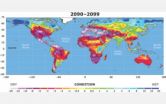(Press-News.org) SEATTLE, Wash.—October 18, 2010—Researchers at the Allen Institute for Brain Science have found that the same genes have different activity patterns in the brain in individuals with different genetic backgrounds. These findings may help to explain individual differences in the effectiveness and side-effect profiles of therapeutic drugs and thus have implications for personalized medicine. The study is available in this week's online early edition of the Proceedings of the National Academy of Sciences (www.pnas.org).
In this study, the authors compared where in the brain each of 49 different pharmaceutically related genes is expressed, or turned on, in seven genetically distinct groups of mice with known genealogical relationships. By analyzing 203 distinct brain areas over 15,000 thin sections of tissue, they precisely mapped where these genes are active, down to the level of individual cells. The genes all encode molecular targets of well-known pharmaceuticals, such as antidepressants, antipsychotics and pain relievers including Prozac, Imitrex, and Aricept.
More than half of the genes examined showed striking, localized differences in expression patterns between the different genetic groups, or strains, of mice. For example, the dopamine D2 receptor gene—which encodes a target of action of Zyprexa, a drug used for schizophrenia and bipolar disorder—is active in a memory-related area called the entorhinal cortex in one strain of mice, but not in two others. Because different parts of the brain have different functions, variations in the localization of gene activity likely have functional implications.
"It is clear that to understand how genes translate to behavioral and other differences between individuals and species, we need to look beyond just the inherited sequences of the genes themselves," said Allan Jones, chief executive officer of the Allen Institute for Brain Science. "Our results show that genetic background—the specific blend of gene variants comprising an individual genome—can influence how the activity of a given gene is regulated and where it is expressed."
Taken all together, the data from the study demonstrate that closer genetic relatives exhibit fewer differences in gene expression patterns, whereas more distant relatives show greater variation. Interestingly, the researchers found that the expression variations between genetic strains were more likely to be found in areas of the brain that evolved more recently. These regions are most commonly linked to higher order functions such as cognition, social behavior, learning and memory.
"This study shows how large-scale datasets can be used to reveal fundamental biological patterns that would likely be missed otherwise," said Jones. "It is likely that many important differences between individuals and species may result from combinations of many small but clear differences in gene expression."
Jones added, "Our ongoing Allen Human Brain Atlas project, which will provide gene expression data across the brains of multiple donors, will help researchers translate these results from an animal model to a human system."
INFORMATION:
The data in this study are openly available to the public as the Mouse Diversity Study via the ALLEN Brain Atlas data portal at www.brain-map.org or directly at mousediversity.alleninstitute.org.
Citation: JA Morris et al. "Divergent and nonuniform gene expression patterns in mouse brain," PNAS, published online October 18, 2010, doi: 10.1073/pnas.1003732107
About the Allen Institute for Brain Science
Launched in 2003, the Seattle-based Allen Institute for Brain Science is an independent, 501(c)(3) nonprofit medical research organization dedicated to advancing brain research. Started with $100 million in seed money from philanthropist Paul G. Allen, the Institute takes on projects at the leading edge of science—far-reaching projects at the intersection of biology and technology. The resulting data create publicly available resources that fuel discovery for countless other researchers worldwide. The Institute's data and tools are available on the Web at www.alleninstitute.org.
Scientists at The Montreal Neurological Institute and Hospital – The Neuro, McGill University have discovered that our brains have the ability to determine the shape of an object simply by processing specially-coded sounds, without any visual or tactile input. Not only does this new research tell us about the plasticity of the brain and how it perceives the world around us, it also provides important new possibilities for aiding those who are blind or with impaired vision.
Shape is an inherent property of objects existing in both vision and touch but not sound. Researchers ...
CHAMPAIGN, Ill. — University of Illinois chemists have developed a simple sensor to detect an explosive used in shoe bombs. It could lead to inexpensive, easy-to-use devices for luggage and passenger screening at airports and elsewhere.
Triacetone triperoxide (TATP) is a high-powered explosive that in recent years has been used in several bombing attempts. TATP is easy to prepare from readily available components and has been difficult to detect. It defies most standard methods of chemical sensing: It doesn't fluoresce, absorb ultraviolet light or readily ionize.
The ...
A study published Oct. 19 in the open access journal Public Library of Science (PLoS) ONE, shows that not just human memories fade. Scientists from Arizona State University and the Norwegian University of Life Sciences examined how aging impacts the ability of honey bees to find their way home.
While bees are typically impressive navigators, able to wend their way home through complex landscapes after visits to flowers far removed from their nests, the study reveals that aging impairs the bees' ability to extinguish the memory of an unsuitable nest site even after the ...
The United States and many other heavily populated countries face a growing threat of severe and prolonged drought in coming decades, according to results of a new study by National Center for Atmospheric Research (NCAR) scientist Aiguo Dai.
The detailed analysis concludes that warming temperatures associated with climate change will likely create increasingly dry conditions across much of the globe in the next 30 years.
The drought may reach a scale in some regions by the end of the century that has rarely, if ever, been observed in modern times.
Using an ensemble ...
Procedural sedation and analgesia is an essential element of care for children requiring painful procedures in the emergency department. The practice of combining ketamine and propofol, two common medications used in emergency departments, has become more popular. However, until recently, it was unclear whether this practice was superior to the use of either agent alone, especially in children.
Research led by Drs. Amit Shah, Gregory Mosdossy and Michael Rieder of the Schulich School of Medicine & Dentistry at The University of Western Ontario and Lawson Health Research ...
AMES, Iowa – The eyes of sheep infected with scrapie – a neurological disorder similar to mad cow disease – return an intense, almost-white glow when they're hit with blue excitation light, according to a research project led by Iowa State University's Jacob Petrich.
The findings suggest technologies and techniques can be developed to quickly and noninvasively test for transmissible spongiform encephalopathies, progressive and fatal neurological diseases such as mad cow disease in cattle and Creutzfeldt-Jakob disease in humans. Petrich, in fact, is working to develop ...
Clear-cut logging and related road-building in the 1950s and 1960s in southern Oregon's Siskiyou Mountains disrupted soil stability and led to unprecedented soil erosion made worse during heavy rainstorms, report University of Oregon researchers.
While logging practices have improved dramatically since then, the damaged landscape -- the removal of low vegetation that helps to protect hillsides during fires and rain -- continues to pose a threat into the foreseeable future, said Daniel G. Gavin, professor of geography, and postdoctoral doctoral researcher Daniele Colombaroli.
Their ...
WASHINGTON, Oct. 19 – One of the main techniques for measuring and monitoring mental activity, called functional near infrared spectroscopy (fNIRS), can often be impaired because a person's hair gets in the way. But now, thanks to a team of researchers at the University of Texas at Dallas and the University of Texas at Arlington, a novel device called a "brush optrode" is providing increased sensitivity with fiber tips designed to thread through hair to enhance scalp contact.
Details of the device will be presented at the Optical Society's (OSA) 94th annual meeting, ...
PHILADELPHIA (October 19, 2010)—Inflammatory breast cancer (IBC), an aggressive and rare malignancy, is often initially misdiagnosed as an infection or rash. However, getting the correct diagnosis quickly is critical for patients because the disease spreads beyond the breast in a matter of just days or weeks. With that in mind, leading specialists from The University of Texas MD Anderson Cancer Center and Fox Chase Cancer Center have written a review of the current scientific and medical understanding of IBC, which includes key information on diagnosis, imaging, treatment, ...
OAK RIDGE, Tenn., Oct. 19, 2010 -- The Cold Triple Axis spectrometer, a new addition to Oak Ridge National Laboratory's High Flux Isotope Reactor and a complementary tool to other neutron scattering instruments at ORNL, has entered its commissioning phase.
The CTAX uses "cold" neutrons from the HFIR cold source to study low-energy magnetic excitations in materials. Cold neutrons are slower than their "thermal" neutron counterparts, and thus perfect for probing low-energy dynamics.
The instrument, which moves by way of air pads on an epoxy surface known as the "dance ...



